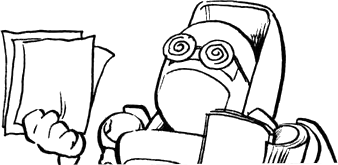Space Family Carlvinson v08 c087
OctonionicThe title for this chapter comes from a famous series of essays, an incredibly influential work of the Meiji period that proposed Westernization of the Japanese educational system. The wordplay in this isn't exactly Western, though, so my apologies for the translator notes.
On the last page, Asari thanks a teacher, whose name I can't decipher. Some of the radicals are a bit compressed in the kanji, so I decided to leave the name blank rather than make an attempt at guessing syllables.
If you haven't seen them before, here's a brief explanation of Japanese “number-puns”: Each digit can be read at least two ways in Japanese, and these readings are usually one syllable long. Since Japanese words have a more rigid syllable structure than English, it's surprisingly common for a Japanese word (or phrase, or sentence) to be recognizable as a string of digits. This is part of the reason why birthdays are so commonly listed for fictional characters: they're a way to slip a pun in.
For example, one sentence that comes up in this chapter is “At the foot of Mt. Fuji, cry ‘Om!’”.
富士山ろくオーム鳴く (Fuji at-foot-of-mountain “Om” chirp/cry/call/sing-nonpast-active)
Phonetically, this is
Fu Ji San Ro Ku Oh - Mu Na Ku
2, with kanji 二, can be pronounced “Fu” (from pre-kanji Japanese) but also “Ni” or “Ji” (derived from Chinese reading of the kanji). In similar fashion, 3 can be pronounced “San”, 6 can be “Roku” but also “Mu”, 7 can be “Na”, and 9 can be “Ku”. Coming from English pronounciation, 0 can be “Oh”. Putting it all together, the sentence can be heard as
2 2 3 6 0 6 7 9
which are the first few digits of √5.
The closest English equivalent I know comes from just using phrases where the letter count of each word is the appropriate digit, with some special cases to handle 0. Hopefully that's clear; I know I've heard the √2 one around at least.

v08c087